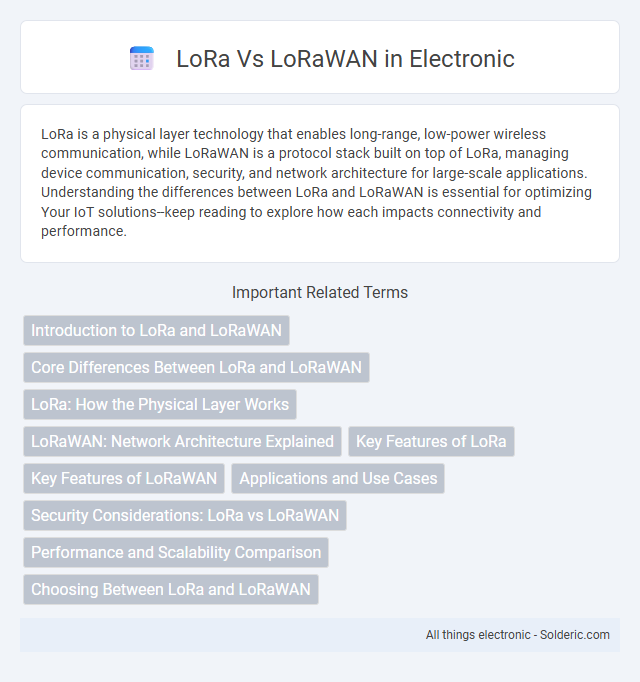LoRa is a physical layer technology that enables long-range, low-power wireless communication, while LoRaWAN is a protocol stack built on top of LoRa, managing device communication, security, and network architecture for large-scale applications. Understanding the differences between LoRa and LoRaWAN is essential for optimizing Your IoT solutions--keep reading to explore how each impacts connectivity and performance.
Comparison Table
| Feature | LoRa | LoRaWAN |
|---|---|---|
| Definition | Long Range wireless modulation technique | Communication protocol & network architecture using LoRa |
| Technology Type | Physical layer (PHY) modulation | MAC layer protocol & network structure |
| Range | Up to 15 km (rural) | Up to 15 km (rural), supports network scalability |
| Data Rate | 0.3 kbps to 50 kbps | 0.3 kbps to 50 kbps |
| Network Topology | Point-to-point | Star-of-stars (end devices, gateways, network server) |
| Security | Basic modulation level | AES-128 encryption, secure key management |
| Use Case | Raw radio modulation for custom solutions | IoT deployments, low-power wide area networks (LPWAN) |
| Standardization | Proprietary modulation by Semtech | Open standard maintained by LoRa Alliance |
Introduction to LoRa and LoRaWAN
LoRa is a proprietary wireless modulation technique designed for long-range, low-power communications, operating in sub-GHz frequency bands ideal for IoT applications. LoRaWAN is the communication protocol and system architecture built on top of LoRa, managing the communication between end devices and network gateways to enable secure and scalable LPWAN networks. Together, LoRa provides the physical layer modulation, while LoRaWAN defines the media access control (MAC) layer, ensuring efficient network management and interoperability.
Core Differences Between LoRa and LoRaWAN
LoRa is a physical layer technology designed for long-range, low-power wireless communication using chirp spread spectrum modulation. LoRaWAN is a network protocol built on top of LoRa, managing communication between end devices and gateways across multiple nodes with defined classes and security features. The core difference lies in LoRa providing the radio modulation while LoRaWAN defines the networking architecture, device management, and data transmission protocols.
LoRa: How the Physical Layer Works
LoRa utilizes chirp spread spectrum modulation to transmit data over long distances with low power consumption, making it ideal for IoT devices in remote or challenging environments. The physical layer of LoRa adjusts the spreading factor to balance data rate and range, optimizing communication by spreading the signal across a wide frequency band. Your devices benefit from robust resistance to interference and improved sensitivity, enabling reliable low-bandwidth data transfer in diverse applications.
LoRaWAN: Network Architecture Explained
LoRaWAN defines the network architecture that organizes communication between LoRa devices and gateways, enabling long-range, low-power IoT connectivity. It uses a star-of-stars topology where end devices transmit data to multiple gateways, which then forward the data to centralized network servers for processing. Your IoT deployments benefit from LoRaWAN's scalable, secure infrastructure that manages device authentication, data encryption, and network management efficiently.
Key Features of LoRa
LoRa (Long Range) is a wireless modulation technology known for its low power consumption, long-range communication capability up to 15 kilometers in rural areas, and robust performance in noisy environments. It utilizes Chirp Spread Spectrum (CSS) modulation, enabling high sensitivity and resistance to interference, making it ideal for IoT applications such as smart metering and asset tracking. LoRa operates primarily in unlicensed frequency bands like 868 MHz in Europe and 915 MHz in North America, facilitating cost-effective and widespread deployment.
Key Features of LoRaWAN
LoRaWAN, built on LoRa's physical layer, offers scalable network architecture designed for large-scale IoT deployments with star-of-stars topology. It features low power consumption, long-range communication up to 15 kilometers in rural areas, and robust security through AES128 encryption. Your devices benefit from adaptive data rates and seamless interoperability among diverse manufacturers, ensuring efficient and reliable connectivity.
Applications and Use Cases
LoRa technology enables long-range, low-power communication ideal for sensor networks in agriculture, smart metering, and asset tracking. LoRaWAN builds on LoRa by providing a network protocol for scalable IoT deployments in smart cities, industrial automation, and environmental monitoring. Industries utilize LoRaWAN for real-time data transmission across wide areas, enhancing operational efficiency and predictive maintenance.
Security Considerations: LoRa vs LoRaWAN
LoRa provides the physical layer and modulation technique for long-range, low-power communication, while LoRaWAN adds the network layer with enhanced security features such as AES-128 encryption for payload data and mutual authentication between devices and gateways. LoRa's security is limited to the modulation level, lacking built-in encryption, making LoRaWAN essential for secure IoT deployments. LoRaWAN's layered security model includes network session keys and application session keys, ensuring data integrity and confidentiality throughout the communication process.
Performance and Scalability Comparison
LoRa provides the physical layer modulation enabling long-range, low-power communication over distances up to 15 km in rural areas, ideal for point-to-point connectivity with minimal energy consumption. LoRaWAN, built on LoRa, adds a network layer supporting device authentication, adaptive data rates, and bidirectional communication, enabling scalable networks that can manage thousands of devices across wide geographic areas. Your network performance improves with LoRaWAN's ability to optimize bandwidth and support high device density, making it more suitable for large-scale IoT deployments compared to standalone LoRa.
Choosing Between LoRa and LoRaWAN
Choosing between LoRa and LoRaWAN depends on your specific connectivity needs and network complexity. LoRa provides the physical layer for long-range, low-power communication, ideal for simple point-to-point connections, while LoRaWAN offers a complete network protocol enabling secure, scalable, and managed communication across multiple devices. Understanding your use case will help you determine whether to implement LoRa's raw capabilities or the full LoRaWAN stack for enhanced device interoperability and network management.
LoRa vs LoRaWAN Infographic

 solderic.com
solderic.com